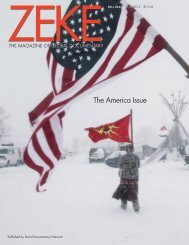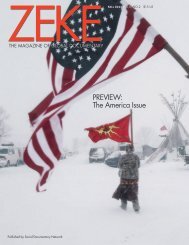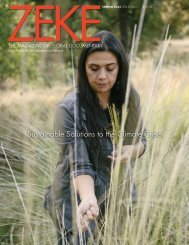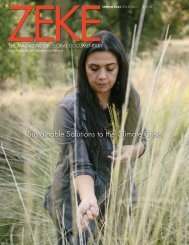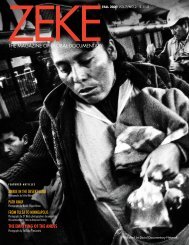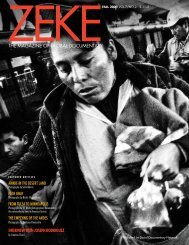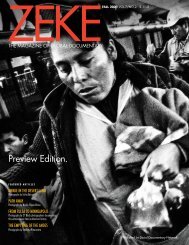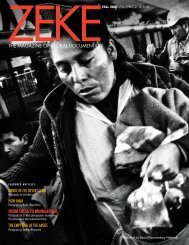ZEKE Magazine: Spring 2023.2
Feature articles on Ecuador by Nicola Ókin Frioli; Ethiopia by Cinzia Canneria, and Ukraine by Svet Jacqueline. Contents: Piatsaw:A Document on the Resistance of the Native Peoples of Ecuadorian Amazon Against Extractivism Photographs by Nicola Ókin Frioli Winner of 2023 ZEKE Award for systemic change Women's Bodies as Battlefield Photographs by Cinzia Canneri Winner of 2023 ZEKE Award for documentary photography Too Young to Fight, Ukraine Photographs by Svet Jacqueline Picturing Atrocity: Ukraine, Photojournalism, and the Question of Evidence by Lauren Walsh Interview with Chester Higgins by Daniela Cohen
Feature articles on Ecuador by Nicola Ókin Frioli; Ethiopia by Cinzia Canneria, and Ukraine by Svet Jacqueline.
Contents:
Piatsaw:A Document on the Resistance of the Native Peoples of Ecuadorian Amazon Against Extractivism
Photographs by Nicola Ókin Frioli
Winner of 2023 ZEKE Award for systemic change
Women's Bodies as Battlefield
Photographs by Cinzia Canneri
Winner of 2023 ZEKE Award for documentary photography
Too Young to Fight, Ukraine
Photographs by Svet Jacqueline
Picturing Atrocity: Ukraine, Photojournalism, and the Question of Evidence
by Lauren Walsh
Interview with Chester Higgins
by Daniela Cohen
Create successful ePaper yourself
Turn your PDF publications into a flip-book with our unique Google optimized e-Paper software.
Subscribe to ZEKE today and
receive print edition. Learn more » »
Maloletka’s Instagram post on January 14, 2023.
“Russia attacked civilian neighbourhood. This is a
War Crime.” Screenshot by the author.
didn’t study war crimes; I don’t have
training. I learned it in the field.”
But his images differ from
investigators’. As a photojournalist,
he prioritizes affect. “You concentrate
mostly on emotions, so viewers can
connect.”
Both Douglas and Betts see
tremendous value in photojournalistic
images, even if the photographer isn’t
trained in IHL. “The photos may help
to corroborate witness testimony. They
may help to flesh out the story that
some of the more forensic information
is offering. And really there’s no
one silver bullet piece of evidence in
these types of trials, because they’re
so vast. It is one incredibly large
evidentiary puzzle,” says Betts. She
adds that the traditional means of
getting photos entered into evidence
is to bring the photographer in to
testify to the fact that they took the
image and have not manipulated it.
“This is still the primary and probably
preferred way of most courts.”
In short, mainstream media and
war crimes investigators bring
differing expectations to their
approach to visual documentation.
As Betts observes, evidence photos
may reveal victim’s identities or
even perpetrators in commission
of the crime itself – imagery that is
sometimes sanitized by media outlets.
Maloletka echoes, “You’re
thinking prior about whether you will
show the faces. You don’t want to,
if possible. If you’re photographing
an injured person, you don’t know
if they will live or die, so you try
to hide their identity, for example,
because you don’t want their
relatives to find out this way.”
Betts and Douglas, while mindful
of limitations, emphasize the benefits
of photojournalistic imagery. “You
might see bodies lying on the
street, but not see their faces,” says
Douglas. “Yet often the identity of the
victims isn’t necessarily crucial if you
are aware that they are civilians,” he
adds, referring to the fact that attacks
on civilians is a violation of IHL.
Maloletka explains that he will
document a graphic scene—even
knowing the AP may not use some
photos for being too brutal—for his
own remembrance, to acknowledge,
if only personally, what he witnessed.
Rarely, he may share those images
publicly, via Instagram, with a
graphic content warning, as he did
in October 2022 with photos of
rotting Russian corpses, because,
as he says, “war is ugly and
Russians should see their own dead
soldiers as well.”
Julia Kochetova, another
Ukrainian photojournalist who has
worked for outlets such as Vice,
Guardian and Der Spiegel, echoes
many of these points. She, too, has
never received any training in crime
scene photography, but assuredly
states, “I witnessed the aftermath of
war crimes in Bucha.”
In relating an episode from
Kherson, Kochetova adds another
layer to this discussion: the
photojournalist cannot alter the
scene. “I saw the body of a woman
who had been raped and killed
violently. You could see the bruises
and the signs of the sexual attack. I
spoke with neighbors who confirmed
that Russians did it. They were in
uniform.”
“I knew that I was the only
person there with a camera so I
needed to document. The body
was partially naked, partially
covered. Her face was obscured
by a jacket. As a journalist, I can’t
change the scene, so I can’t move
the jacket to reveal her identity. I
have the photos of what I saw.”
This of course differs from the
work of investigators, who would
collect and preserve physical
evidence, take measurements and
statements, and document the entire
scene and each piece of evidence
photographically.
Bodies of civilians who died during the evacuation of Irpin when Russian troops opened mortar and artillery
fire on them. Irpin, Kyiv region, Ukraine, March 6, 2022. © Maxim Dondyuk.
ZEKE SPRING 2023/ 53








